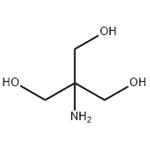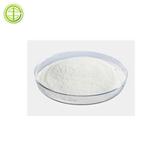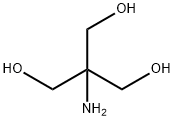Tris(hydroxymethyl)aminomethane: Applications in Skincare Products and Side Effects
Nov 6,2024
Tris(hydroxymethyl)aminomethane, commonly known as Trometamol, Tris base, or Trizma base, plays a vital role as a biological buffer in a variety of research applications. Due to its optimal pKa of 8.1, it is widely used in the formulation of buffers such as triethyl acetate-EDTA (TAE) and triethyl borate-EEDTA (TBE), making it well suited to maintain pH within the physiological range (pH 7-9) applicable to most organisms. However, caution may be required when studying certain proteins, as Tris has the potential to interfere with the activity of certain enzymes. Tris base can be used as a buffer on its own or as a component in mixed buffer formulations, including Tris-EDTA (TE) buffer, TAE buffer, and TBE buffer.

Figure 1. Tris(hydroxymethyl)aminomethane
Product Applications
1. Tris(hydroxymethyl)aminomethane can be used as a buffer solution for lactate dehydrogenase assays, in situ hybridization procedures, and protein extraction from cells.
2. As a buffer in flow cell sample preparation for Raman spectroscopy.
3. As a wash buffer in protein blotting.
4. As a buffer component for tissue decellularization.
5. As a buffer in aquaculture farms.
The scientific principle of buffers
The key to why tris(hydroxymethyl)aminomethane can be an excellent buffer is that the amino group in its molecule can accept protons (H+) to form positively charged ions, while the hydroxyl group can release protons to become negatively charged ions. This ability to accept and release protons enables TRIS to maintain the relative stability of the solution pH value by quickly adjusting its own ionization state when the external pH changes. This dynamic equilibrium mechanism provides a stable environment for biochemical reactions and protects the activity and structural integrity of biological molecules.
- Related articles
- Related Qustion
- Uses and Preparation of Trometamol Jul 29, 2022
Trometamol, also known as Tromethamine; 2-amino-2-(hydroxymethyl)-1,3-propanediol, is a white Chemicalbook-colored crystal or powder.
- Applications of Tris(hydroxymethyl)aminomethane Nov 7, 2019
Tris is an established basimetric standard and buffer used in biochemistry and molecular biology. It may be used by itself as a buffer or as a component of mixed buffer formulations.
Supplementation with pyridoxal 5'-phosphate monohydrate can synthesize neurotransmitters such as dopamine and serotonin, maintaining a healthy nervous system.....
Nov 4,2025Biochemical EngineeringGlyphosate inhibits EPSPS, disrupting plant growth. In the body, it shows rapid but incomplete absorption, minimal accumulation, and elimination primarily through feces and urine.....
Nov 6,2024Pesticide IntermediatesTris(hydroxymethyl)aminomethane
77-86-1You may like
Tris(hydroxymethyl)aminomethane manufacturers
- Tris Base
-

- 2025-11-06
- CAS:77-86-1
- Min. Order:
- Purity: 0.99
- Supply Ability:
- Trometamol
-

- $0.00 / 1Kg/Bag
- 2025-11-06
- CAS:77-86-1
- Min. Order: 1Kg/Bag
- Purity: 0.99
- Supply Ability: 20 tons
- Tris(hydroxymethyl)aminomethane
-

- $999.00/ ton
- 2025-11-06
- CAS:77-86-1
- Min. Order: 1ton
- Purity: 99%
- Supply Ability: 5000






